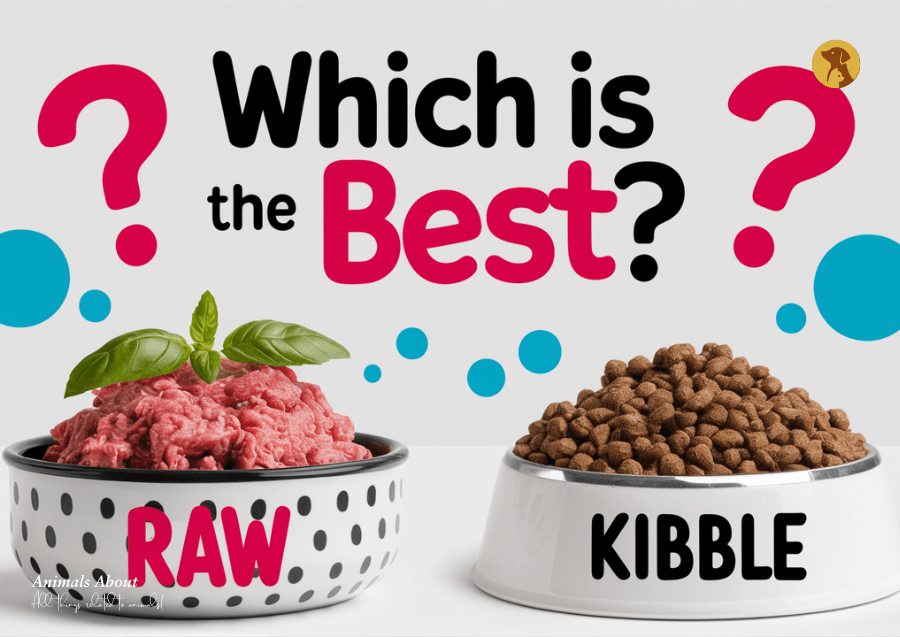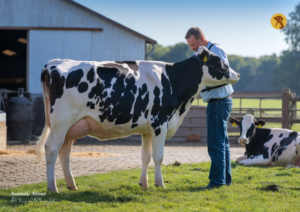Raw vs Kibble Dog Food – As loving dog owners, we all want what’s best for our furry friends. One of the biggest decisions you’ll make as a pet parent is choosing the right food. The debate of raw vs kibble dog food has been ongoing for years. Some pet parents swear by the natural, ancestral benefits of raw feeding, while others prefer the safety, convenience, and affordability of kibble. It’s no surprise that dog lovers often find themselves overwhelmed with conflicting opinions when trying to make the best decision.
So, how do you decide which is best for your dog? The answer depends on a number of factors including your dog’s age, breed, activity level, any existing health conditions, and your own lifestyle. In this article, we’ll break down everything you need to know — the pros, cons, health risks, nutritional facts, and expert insights. Whether you’re considering feeding dogs raw meat or comparing brands of dry dog food, we’ve got you covered with a simple, easy-to-understand guide designed to help you make an informed decision for your pet.
Understanding the Two Types of Dog Food
Before diving into the comparison, let’s clearly define each option to understand their core differences.
What is Raw Dog Food?
Raw dog food typically includes uncooked meat, bones, organs, and sometimes fruits, vegetables, and supplements. This feeding approach is commonly known as the BARF diet (Biologically Appropriate Raw Food). The idea behind this diet is to mirror what a dog’s ancestors might have eaten in the wild before commercial pet food became the norm. It emphasizes natural, unprocessed ingredients that are packed with nutrients.
Proponents of raw feeding believe this approach is more biologically suitable for dogs and can provide numerous health benefits. A raw diet often includes a wide range of fresh ingredients such as raw beef, chicken, turkey, or lamb, raw bones (like chicken wings or necks), liver and other organs, raw eggs, and sometimes fresh fruits and vegetables for fiber and vitamins. Some pet owners also add fish oils or supplements to make sure their dogs are getting a complete range of nutrients.
What is Kibble?
Kibble, on the other hand, is a type of commercial dog food that has been cooked at high temperatures and processed into dry, bite-sized pellets. It typically contains meat by-products, grains, vegetables, vitamins, and preservatives. The key advantage of kibble is that it is designed to be shelf-stable, affordable, and easy to serve.
Most kibble brands aim to meet the nutritional standards set by pet food regulatory bodies. Some premium brands have improved their formulas to include real meat, avoid fillers, and provide grain-free or limited ingredient options. Freeze-dried dog food, grain-free kibble, and organic varieties have also gained popularity among health-conscious pet owners. Despite its convenience, kibble is sometimes criticized for containing processed ingredients and lacking the freshness of raw diets.
Raw Dog Food Benefits
Many dog owners have reported noticeable improvements in their pets’ health and vitality after switching to a raw diet. Here are some of the key benefits associated with raw feeding:
1. Improved Digestion
Dogs on raw diets often experience better digestion, resulting in smaller, firmer stools and less frequent bowel movements. Raw food typically avoids the fillers and carbohydrates found in kibble, which can lead to dog digestion issues. The higher moisture content in raw food also helps maintain hydration, which supports kidney function and digestive health.
2. Shinier Coat and Healthier Skin
A raw diet rich in omega-3 fatty acids, proteins, and essential nutrients often leads to a shinier coat and healthier skin. Dogs that suffer from allergies or dry, flaky skin may find relief with the switch to raw. Since raw food is free of artificial additives and chemicals, it reduces the likelihood of skin irritations and allergic reactions.
3. More Energy and Vitality
Many pet owners report that their dogs become more energetic and alert after transitioning to raw food. This can be attributed to the diet’s high-quality protein content and nutrient density, which supports muscle development, immune function, and overall vitality. A biologically appropriate diet helps dogs perform at their best.
4. Better Dental Health
Chewing on raw bones is a natural way to clean your dog’s teeth. It helps scrape off plaque and tartar, promoting healthier gums and reducing bad breath. This form of natural dental care is especially helpful for dogs that resist toothbrushing or dental chews.
5. Natural and Unprocessed
Raw food avoids artificial preservatives, colors, and by-products, making it a great option for those who want to feed their pets a natural dog food diet. By sticking to whole, unprocessed ingredients, you ensure that your dog is eating food closer to what nature intended.
Risks and Challenges of Raw Feeding
While raw feeding offers many benefits, it is not without its challenges and risks. It requires careful planning and a solid understanding of canine nutrition.
1. Bacterial Contamination
Handling raw meat increases the risk of contamination from bacteria such as Salmonella and E. coli. This can pose health risks not only to your dog but also to humans in the household, especially children, the elderly, or those with weakened immune systems. Proper hygiene and food safety practices are essential when preparing raw meals.
2. Nutritional Imbalance
Creating a nutritionally complete raw diet is complex. If not done properly, it can lead to deficiencies in essential vitamins and minerals like calcium, phosphorus, and vitamin D. That’s why it is important to follow a proven recipe or consult with a veterinary nutritionist when starting raw feeding.
3. Time and Effort
Raw feeding requires more effort than scooping kibble into a bowl. It involves meal planning, shopping for fresh ingredients, measuring portions, and storing food safely. This can be challenging for busy pet owners or those with limited access to fresh, quality meats.
4. Cost
Due to the need for high-quality, fresh ingredients, the cost of raw feeding is generally higher than kibble. For owners of large dogs or multiple pets, this can quickly become expensive. It’s important to weigh the long-term health benefits against the financial commitment.
The Case for Kibble: Is Processed Dog Food All Bad?
Kibble often gets a bad reputation among raw feeding enthusiasts, but it’s not inherently harmful. In fact, many vets and pet nutritionists recommend high-quality kibble for its convenience, affordability, and balanced formulation.
Advantages of Kibble
- Convenient and Easy: Kibble is quick to serve, easy to store, and doesn’t require preparation or refrigeration. This makes it ideal for busy households or when traveling.
- Nutritionally Balanced: Reputable kibble brands are formulated to provide complete and balanced nutrition. They undergo rigorous testing to ensure they meet pet food safety standards.
- Affordable: Kibble is typically more budget-friendly than raw food, making it accessible for a wider range of pet owners.
- Shelf-Stable: Unlike raw food, kibble can be stored at room temperature for long periods without spoiling, reducing waste and the need for refrigeration.
- Widely Available: Kibble can be purchased from almost any pet store, grocery store, or online retailer, offering a wide variety of formulas for specific dog needs.
Concerns About Kibble
Despite its benefits, kibble does have some downsides:
- Some brands may use low-quality ingredients and meat by-products instead of whole meat.
- Artificial preservatives, flavors, and colors can lead to allergic reactions or sensitivities.
- High carbohydrate content in some kibble can contribute to obesity, especially in less active dogs.
- The processing methods may reduce the natural bioavailability of nutrients compared to raw food.
Raw vs Kibble Dog Food: A Side-by-Side Comparison
| Feature | Raw Dog Food | Kibble (Dry Dog Food) |
| Nutrition | High in natural enzymes and protein | Balanced formulas, but may be overly processed |
| Convenience | Time-consuming, needs prep and storage | Easy to store, measure, and serve |
| Cost | Expensive, especially with quality meat | Budget-friendly |
| Shelf Life | Short, requires refrigeration or freezing | Long-lasting, no refrigeration needed |
| Safety | Risk of bacteria contamination | Generally safe due to heat processing |
| Digestibility | Can improve digestion for some dogs | May cause issues if low-quality ingredients |
| Customizability | Tailored to individual dog needs | Limited unless using specialized formulas |
| Dental Health | Natural chewing benefits from bones | Requires dental chews or brushing |
What Do Vets Say?
Veterinarians tend to be cautious about raw feeding, especially when done without professional guidance. Vet recommendations on dog food often lean toward kibble because of its balanced nutrition and lower risk of contamination. However, some holistic and integrative vets support raw diets, especially when they are professionally formulated and safely prepared.
Before making any significant changes to your dog’s diet, it is always best to consult with your vet. Ask whether raw feeding is suitable for your dog’s specific needs and whether supplements are necessary. Your vet can also help monitor your dog’s health and ensure the new diet supports long-term well-being.
Is Mixing Raw and Kibble a Good Idea?
Some pet owners opt for a hybrid diet, feeding raw food in the morning and kibble in the evening, or rotating weekly. While this can offer a balance between nutrition and convenience, it’s important to transition gradually to avoid digestive upset. Mixing the two types of food in one meal can be controversial due to differences in digestion rates, so speak with your vet if you’re considering this approach.
Homemade Dog Food: A Middle Ground?
If you’re unsure about raw feeding but want to avoid highly processed kibble, homemade cooked meals might be a good compromise. These diets use fresh ingredients that are gently cooked to eliminate harmful bacteria while retaining more nutrients than heavily processed food. Just like raw diets, homemade food must be nutritionally balanced. Consulting a pet nutritionist is highly recommended to ensure your dog receives all essential vitamins and minerals.
Which Is the Best Diet for Dogs?
There is no one-size-fits-all answer when it comes to choosing between raw vs kibble dog food. The best option depends on your dog’s individual health needs, your lifestyle, and your budget.
Choose raw if:
- You can commit to the time, effort, and cost
- You want to avoid processed food entirely
- You are comfortable handling and preparing raw ingredients
- Your dog thrives on a fresh, natural diet
Choose kibble if:
- You prefer convenience and affordability
- Your dog does well on commercial food
- You trust a brand that uses high-quality, natural ingredients
- You want consistent, regulated nutrition with minimal effort
The best diet for dogs is the one that keeps them healthy, happy, and full of life. Always monitor how your dog responds to their diet and adjust as needed. Your dog’s health and well-being should be the ultimate guide.
Final Thoughts
Whether you’re leaning toward feeding dogs raw meat or opting for the ease of commercial dog food, remember this: every dog is unique. What works for one may not work for another. Focus on high-quality ingredients, consult your veterinarian, and observe how your dog reacts to their meals. From grain-free kibble to raw bones for dogs, your goal is the same — a long, happy, and healthy life for your beloved companion.







